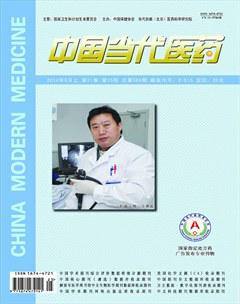胃蛋白酶原Ⅰ聯合胃泌素—17檢測對慢性萎縮性胃炎發病部位及胃癌進展時期的預測價值
周海平
[摘要] 目的 探討胃蛋白酶原Ⅰ(PGⅠ)聯合胃泌素-17(G-17)檢測對慢性萎縮性胃炎發病部位及胃癌進展時期的預測價值。 方法 選擇本院收治的慢性萎縮性胃炎患者33例、胃癌患者35例作為研究對象,進行PGⅠ、PGⅡ和G-17檢測,比較并分析PGⅠ、PGⅡ及G-17水平的變化情況。 結果 慢性萎縮性胃炎組PGⅠ和G-17水平高于胃癌組,差異有統計學意義(P<0.05),胃竇部組的PGⅠ水平高于胃體部組和全胃彌漫組,差異有統計學意義(P<0.05),胃體部組的G-17水平高于全胃彌漫組和胃竇部組,差異有統計學意義(P<0.05),早期胃癌或原位癌的PGⅠ和G-17水平顯著高于進展期胃癌,差異有統計學意義(P<0.05)。 結論 胃竇部發病為主的慢性萎縮性胃炎其G-17顯著下降,胃體部或全胃病變者PGⅠ的下降更加明顯,進展期胃癌者PGⅠ水平更低而G-17水平更高。
[關鍵詞] 胃蛋白酶原Ⅰ;胃泌素-17;預測;慢性萎縮性胃炎部位;胃癌進展
[中圖分類號] R446.11+9 [文獻標識碼] A [文章編號] 1674-4721(2014)09(a)-0126-03
The prediction vaule of pepsinogenⅠ combined with gastrin-17 in lesion location of chronic atrophic gastritis and the period of gastric cancer progression
ZHOU Hai-ping
Department of Elderly Cadre,People′s Hospital of Yichun City in Jiangxi Province,Yichun 336000,China
[Abstract] Objective To investigate the prediction vaule of pepsinogenⅠ combined with gastrin-17 in lesion location of chronic atrophic gastritis and the period of gastric cancer progression. Methods 33 cases with chronic atrophic gastritis and 35 cases in the different period of gastric cancer in our hospital were selected as research objects.All these participants were detected by pegsinogenⅠ,pegsinogenⅡ and gastrin-17.The level of pegsinogenⅠ,pegsinogenⅡ and gastrin -17 were compared and analyzed. Results The level of pepsinogens I and gastrin-17 in chronic atrophic gastritis group were higher than that in gastric cancer group,with statistical difference(P<0.05).Pepsinogen I level in the gastric antrum of chronic atrophic gastritis was higher than that in the gastric body and the total diffuse,with statistical difference(P<0.05),the gastrin-17 level in the gastric body was higher than that in the total diffuse and in the gastric antrum,with statistical difference(P<0.05).Pepsinogen I and gastrin-17 lever of early gastric cancer and carcinoma in situ were higher than advanced gastric carcinoma,with statistical difference(P<0.05). Conclusion The gastrin-17 in gastric antrum of chronic atrophic gastritis decreases significantly,pepsinogen I fell more sharply in the gastric body and the total diffuse,pepsinogen I level decreases significantly and the gastrin-17 level increases significantly with progression of gastric cancer.
[Key words] PepsinogenⅠ;Gastrin-17;Prediction;Lesion location of chronic atrophic gastritis;Progression of gastric carcinoma
胃蛋白酶原(pegsinogen,PG)表達異常的人群發生慢性萎縮性胃炎甚至進展為胃癌的可能性相對于正常人群顯著增加,可以將其列為胃癌的高危人群,聯合血清PG和胃泌素檢測對于診斷臨床微小胃癌甚至原位癌具有較高的敏感性和特異性,而進展期胃癌患者血清內血清PGⅠ與胃泌素-17(gastrin-17,G-17)的水平更低,高分化患者其水平低于低分化者[1-2]。其中PG聯合G-17檢測在慢性萎縮性胃炎以及胃癌中的價值已得到臨床驗證,但是其與慢性萎縮性胃炎具體發病部位及胃癌具體進展時期之間的關系尚未明確[3],本研究通過對PGⅠ與G-17的檢測,探討其在預測慢性萎縮性胃炎發病部位以及胃癌進展時期中的價值。endprint
1 資料與方法
1.1 一般資料
選擇2008年1月~2012年6月本院收治的慢性萎縮性胃炎患者33例、胃癌患者35例作為研究對象,所有患者均經病理檢查確診,其中慢性萎縮性胃炎組:男18例,女15例;年齡38~76歲,平均(56.8±5.4)歲。胃癌組:男18例,女17例;年齡40~78歲,平均(58.1±6.1)歲。
1.2 方法
所有患者入院后均抽取晨起空腹靜脈血4 ml,送檢驗室行離心處理后保持于-20℃冰箱內,其中PG測定采用膠乳增強免疫比濁法(北京九強公司提供試劑盒),標準品采用雅培公司放射免疫分析法之標準比對品,并通過羅氏公司生產的Modular P800型檢測儀嚴格按照說明書進行PGⅠ和PGⅡ的檢測;G-17的檢測采用反射免疫法(北京福瑞公司提供試劑盒),通過合肥眾成機電公司生產的DFM-96型放射免疫計數器,嚴格按照說明書進行測定。所有患者均通過胃鏡檢查確定病變部位和范圍,并留取病理組織標本送病理檢查確診。
1.3 觀察指標
比較慢性萎縮性胃炎與胃癌患者PGⅠ、PGⅡ及G-17水平,并分析慢性萎縮性胃炎患者不同發病部位和胃癌患者不同發病時期PGⅠ、PGⅡ及G-17水平的變化情況。
1.4 統計學處理
采用SPSS 13.0統計學軟件對數據進行處理,計量資料以x±s表示,采用t檢驗,計數資料采用χ2檢驗,以P<0.05為差異有統計學意義。
2 結果
2.1 兩組PGⅠ、PGⅡ及G-17水平的比較
慢性萎縮性胃炎組PGⅠ和G-17水平均高于胃癌組,差異有統計學意義(P<0.05),PGⅡ水平比較,差異無統計學意義(P>0.05)(表1)。
表1 兩組PGⅠ、PGⅡ及G-17水平的比較(x±s)
2.2 慢性萎縮性胃炎組不同發病部位PGⅠ、PGⅡ及G-17水平的比較
胃竇部組的PGⅠ水平高于胃體部組和全胃彌漫組,差異有統計學意義(P<0.05),胃體部組的G-17水平高于全胃彌漫組和胃竇部組,差異有統計學意義(P<0.05),各部位間PGⅡ水平比較差異無統計學意義(P>0.05)(表2)。
表2 慢性萎縮性胃炎組不同發病部位PGⅠ、PGⅡ及G-17
水平的比較(x±s)
2.3 胃癌組不同發病時期PGⅠ、PGⅡ及G-17水平的比較
早期胃癌或原位癌的PGⅠ和G-17水平顯著高于進展期胃癌,差異有統計學意義(P<0.05);PGⅡ水平比較,差異無統計學意義(P>0.05)(表3)。
表3 胃癌不同發病時期PGⅠ、PGⅡ及G-17水平的比較(x±s)
3 討論
PG是人體分泌的胃蛋白酶的前體,胃黏膜中的主細胞和頸黏液細胞主要分泌PGⅠ和極少量的PGⅡ,賁門及幽門的腺體細胞則主要分泌PGⅡ,同時前列腺和胰腺也具有分泌少量PGⅡ的功能。PGⅠ和PGⅡ是兩種不同免疫活性的胃蛋白酶[4],血清內不同PG的水平可以反映胃黏膜中不同部位的形態及功能,其中PGⅠ主要是檢測胃泌酸細胞功能的指標,在胃酸過多的情況下,PGⅠ水平顯著升高,其分泌量的減少則可能發生胃黏膜腺體的萎縮,而PGⅡ的分泌量則是反應胃底黏膜病變的相關指標[5],其升高可能與胃底腺管的萎縮及腸上皮化生甚至惡性腫瘤的發生有關,而兩者的比值(PGⅠ/PGⅡ)如果出現動態性降低,則應警惕萎縮性胃炎的發生。G-17主要由消化系統的G細胞分泌,是一種重要的調節消化道功能和維持消化道結構完整的內分泌激素,超過80%的G-17為胃竇部G細胞分泌,人體中95%以上的活化胃泌素為α-酰氨胃泌素。針對PGⅠ與G-17整體變化而言,慢性萎縮性胃炎組PGⅠ和G-17水平均高于胃癌組。
在慢性萎縮性胃炎發病過程中,胃黏膜固有腺體數量減少,功能減退,導致黏膜萎縮、變薄。對小鼠的實驗研究表明,在慢性萎縮性胃炎患者中,由于胃底腺的數量減少,故合并有主細胞、頸黏液細胞的減少,從而導致PGⅠ水平降低[6-7],另外由于分泌PGⅡ的細胞較多,且其分布廣泛,尤其是腸腺、前列腺亦可分泌少量的PGⅡ,因此在發生慢性萎縮性胃炎時,PGⅡ的下降無明顯改變。血清中PGⅠ的降低是診斷萎縮性胃體胃炎的良好指標,可以用來診斷萎縮性胃炎并提示胃癌高危,從而檢出可根治的早期胃癌[8]。本研究顯示,慢性萎縮性胃炎發病部位在胃竇部者PGⅠ水平高于胃體部者和全胃彌漫者,G-17水平中胃體部者高于全胃彌漫者和胃竇部者,慢性萎縮性胃炎胃鏡檢查可以發現其病灶主要呈灶性分布,且病變多發生于胃小彎側,并逐漸擴散而波及胃竇甚至胃體部,存在緩慢融合的趨勢,而且隨著病變的進展,胃部正常腺體分泌功能受到的影響逐漸加大甚至喪失分泌功能,同時酶的合成與分泌功能亦會受到波及[9]。病變部位在胃竇時,其內腺體喪失導致G細胞數量減少,進入血液循環的G-17水平降低;胃體萎縮時,胃酸分泌降低,對胃竇G細胞的抑制作用減弱,導致G-17分泌增加,血清G-17水平升高。
慢性萎縮性胃炎被認為是胃癌的過渡病變,慢性萎縮性胃炎-腸化生-不典型增生-胃癌是常見的腸型胃癌發生的4個階段[10-11]。血清PG檢測在早期胃癌篩查方面優于X線雙對比造影,國外研究建議將PGⅠ<70 ng/ml、PGⅠ/PGⅡ<3.0定為擬診斷臨界值,尤其是對于具有顯著臨床表現的腸型胃癌,以及病灶小且位于賁門和胃前壁、放射性檢查方法較易漏診的腫瘤效果更佳。血清G-17檢測是近年來興起的應用于篩查早期胃癌的指標之一,聯合PG檢查,當PGⅠ<45 ng/ml、G-17>60 pg/ml時,為擬診斷臨界值。本研究顯示,早期胃癌或原位癌的PGⅠ和G-17水平顯著高于進展期胃癌;胃竇部發病為主的慢性萎縮性胃炎其G-17顯著下降,PGⅠ下降不明顯,而胃體部或全胃病變者PGⅠ下降程度更加顯著;胃癌患者中,進展期胃癌者PGⅠ水平更低而G-17水平更高。endprint
[參考文獻]
[1] Ghoshal UC,Kumar S,Krishnani N,et al.Serological assessment of gastric intestinal metaplasia and atrophy using pepsinogen-Ⅰ,pepsinogen-Ⅱ and gastrin-17 levels in a low incidence area of gastric cancer endemic for H.pylori infection[J].Trop Gastroenterol,2011,32(4):292-298.
[2] Nasrollahzadeh D,Aghcheli K,Sotoudeh M,et al.Accuracy and cut-off values of pepsinogensⅠ,Ⅱ and gastrin 17 for diagnosis of gastric fundic atrophy:influence of gastritis[J].PLoS One,2011,6(10):e26957.
[3] Colarossi A,Inga R,Prochazka R,et al.Pepsinogen and gastrin in the noninvasive diagnosis of gastric atrophy.A case-control study in Peruvian population[J].Rev Gastroenterol Peru,2011,31(2):110-115.
[4] 付華.血清胃蛋白酶原以及胃泌素-17與慢性胃炎[J].貴陽醫學院學報,2011,36(2):187-189.
[5] 曹勤,冉志華,蕭樹東.檢測血清胃蛋白酶原和胃泌素-17診斷胃癌的臨床價值[J].胃腸病學和肝病學雜志,2007, 16(4):361-364.
[6] 馬穎杰,王惠吉.血清胃蛋白酶原、胃泌素-17與慢性萎縮性胃炎[J].胃腸病學,2007,12(7):422-424.
[7] 黃蔚,蔡美珠,吳瑤,等.血清胃蛋白酶原和胃泌素-17聯合檢測在老年胃癌及萎縮性胃炎中的臨床意義[J].中國醫藥指南,2008,6(4):134-136.
[8] 楊俊,厲朝喜,戴一揚,等.三葉因子1蛋白與血清胃蛋白酶原在胃潰瘍中的表達及其意義[J].中華醫學雜志,2012,92(22):1540-1543.
[9] 易楠,王玨,王江紅.血清胃蛋白酶原在胃癌及胃癌前病變診斷中的意義[J].重慶醫學,2011,40(27):2722-2723.
[10] 高海燕,于秀艷,汪杰.血清胃蛋白酶原(PGⅠ)測定對胃癌的診斷意義[J].中國實驗診斷學,2009,13(9):1250.
[11] 楊勤,姚玉玲.胃蛋白酶原與胃泌素檢測對慢性萎縮性胃炎的診斷價值探討[J].實用臨床醫藥雜志,2012,16(23):23-24,31.
(收稿日期:2014-07-17 本文編輯:祁海文)endprint
[參考文獻]
[1] Ghoshal UC,Kumar S,Krishnani N,et al.Serological assessment of gastric intestinal metaplasia and atrophy using pepsinogen-Ⅰ,pepsinogen-Ⅱ and gastrin-17 levels in a low incidence area of gastric cancer endemic for H.pylori infection[J].Trop Gastroenterol,2011,32(4):292-298.
[2] Nasrollahzadeh D,Aghcheli K,Sotoudeh M,et al.Accuracy and cut-off values of pepsinogensⅠ,Ⅱ and gastrin 17 for diagnosis of gastric fundic atrophy:influence of gastritis[J].PLoS One,2011,6(10):e26957.
[3] Colarossi A,Inga R,Prochazka R,et al.Pepsinogen and gastrin in the noninvasive diagnosis of gastric atrophy.A case-control study in Peruvian population[J].Rev Gastroenterol Peru,2011,31(2):110-115.
[4] 付華.血清胃蛋白酶原以及胃泌素-17與慢性胃炎[J].貴陽醫學院學報,2011,36(2):187-189.
[5] 曹勤,冉志華,蕭樹東.檢測血清胃蛋白酶原和胃泌素-17診斷胃癌的臨床價值[J].胃腸病學和肝病學雜志,2007, 16(4):361-364.
[6] 馬穎杰,王惠吉.血清胃蛋白酶原、胃泌素-17與慢性萎縮性胃炎[J].胃腸病學,2007,12(7):422-424.
[7] 黃蔚,蔡美珠,吳瑤,等.血清胃蛋白酶原和胃泌素-17聯合檢測在老年胃癌及萎縮性胃炎中的臨床意義[J].中國醫藥指南,2008,6(4):134-136.
[8] 楊俊,厲朝喜,戴一揚,等.三葉因子1蛋白與血清胃蛋白酶原在胃潰瘍中的表達及其意義[J].中華醫學雜志,2012,92(22):1540-1543.
[9] 易楠,王玨,王江紅.血清胃蛋白酶原在胃癌及胃癌前病變診斷中的意義[J].重慶醫學,2011,40(27):2722-2723.
[10] 高海燕,于秀艷,汪杰.血清胃蛋白酶原(PGⅠ)測定對胃癌的診斷意義[J].中國實驗診斷學,2009,13(9):1250.
[11] 楊勤,姚玉玲.胃蛋白酶原與胃泌素檢測對慢性萎縮性胃炎的診斷價值探討[J].實用臨床醫藥雜志,2012,16(23):23-24,31.
(收稿日期:2014-07-17 本文編輯:祁海文)endprint
[參考文獻]
[1] Ghoshal UC,Kumar S,Krishnani N,et al.Serological assessment of gastric intestinal metaplasia and atrophy using pepsinogen-Ⅰ,pepsinogen-Ⅱ and gastrin-17 levels in a low incidence area of gastric cancer endemic for H.pylori infection[J].Trop Gastroenterol,2011,32(4):292-298.
[2] Nasrollahzadeh D,Aghcheli K,Sotoudeh M,et al.Accuracy and cut-off values of pepsinogensⅠ,Ⅱ and gastrin 17 for diagnosis of gastric fundic atrophy:influence of gastritis[J].PLoS One,2011,6(10):e26957.
[3] Colarossi A,Inga R,Prochazka R,et al.Pepsinogen and gastrin in the noninvasive diagnosis of gastric atrophy.A case-control study in Peruvian population[J].Rev Gastroenterol Peru,2011,31(2):110-115.
[4] 付華.血清胃蛋白酶原以及胃泌素-17與慢性胃炎[J].貴陽醫學院學報,2011,36(2):187-189.
[5] 曹勤,冉志華,蕭樹東.檢測血清胃蛋白酶原和胃泌素-17診斷胃癌的臨床價值[J].胃腸病學和肝病學雜志,2007, 16(4):361-364.
[6] 馬穎杰,王惠吉.血清胃蛋白酶原、胃泌素-17與慢性萎縮性胃炎[J].胃腸病學,2007,12(7):422-424.
[7] 黃蔚,蔡美珠,吳瑤,等.血清胃蛋白酶原和胃泌素-17聯合檢測在老年胃癌及萎縮性胃炎中的臨床意義[J].中國醫藥指南,2008,6(4):134-136.
[8] 楊俊,厲朝喜,戴一揚,等.三葉因子1蛋白與血清胃蛋白酶原在胃潰瘍中的表達及其意義[J].中華醫學雜志,2012,92(22):1540-1543.
[9] 易楠,王玨,王江紅.血清胃蛋白酶原在胃癌及胃癌前病變診斷中的意義[J].重慶醫學,2011,40(27):2722-2723.
[10] 高海燕,于秀艷,汪杰.血清胃蛋白酶原(PGⅠ)測定對胃癌的診斷意義[J].中國實驗診斷學,2009,13(9):1250.
[11] 楊勤,姚玉玲.胃蛋白酶原與胃泌素檢測對慢性萎縮性胃炎的診斷價值探討[J].實用臨床醫藥雜志,2012,16(23):23-24,31.
(收稿日期:2014-07-17 本文編輯:祁海文)endprint

